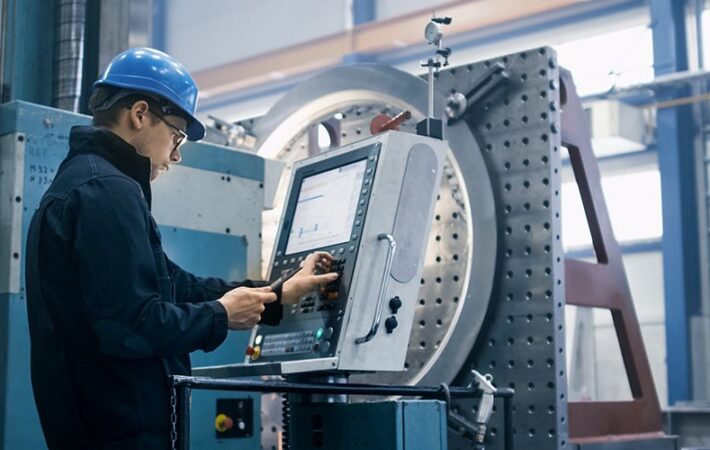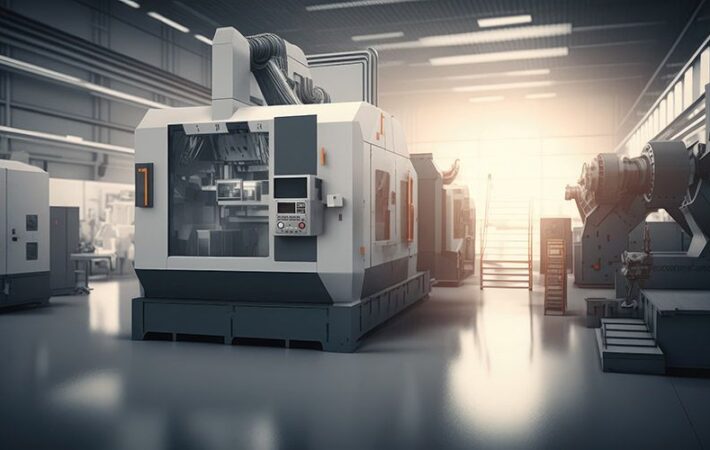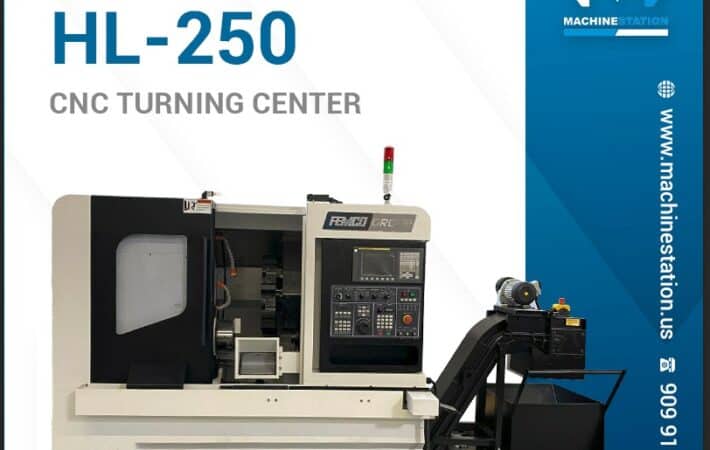Introduction
Machining is evolving and advancing all the time thanks to innovative technologies and new applications. In this guide, we’ll discuss multi-axis machining centers, providing information about what they are, the benefits they offer and how they are used.
What is CNC machining?
Before we delve deeper into multi-axis machining centers, it’s beneficial to talk about what CNC machining is and how it works. CNC stands for Computer Numerical Control. It involves working with machines, computer-controlled tools and equipment that manufacture parts or components from raw materials. CNC machining covers a wide range of tools and machines, including lathes, grinders and turning mills. These tools cut, carve, shape and mold different elements to create parts during the manufacturing process. CNC machines are often referred to as robots because they follow instructions via software programs.
CNC machining is used widely across several industries, including:
- Automotive
- Aerospace
- Telecommunications
- Oil and gas
- Medicine
- Marine
- Military and defense
There are various types of CNC machining, including multi-axis CNC machining.
What is a multi-axis machining center?
Multi-axis machining has become increasingly popular in recent years. This is a form of CNC machining, which is characterized by the use of tools that have more than three axes of movement. Multi-axis machining is defined as machining with more than three axes. This means that the process utilizes more than the standard X, Y and Z axes. There are usually up to nine axes of movement. Multi-axis CNC machining centers offer additional applications and capabilities when compared to machines that operate via three axes.
The multi-axis machining center manufacturing process involves tools that can move in at least four directions. These computer-controlled tools are compatible with a wide range of materials, which means that they provide benefits across several sectors. Depending on the instructions issued by the operator, the machinery will mill or cut away excess materials and shape the remaining material to create functional parts and components. Increasing the range of movement provides manufacturers with additional functions and capabilities.
5-axis machining is a very common type of multi-axis machining. Using a 5-axis machine allows the manufacturer to utilize tools that target five sides of an object by moving across five axes simultaneously. This includes the standard X, Y and Z axes, as well as the A and B axes.
What is a multi-axis machining center used for?
Multi-axis machining is increasingly commonplace and it offers benefits for manufacturers across multiple industries. As technology advances, the demand for CNC machining rises. Statistics show that the CDC industry has grown exponentially in recent years. The industry is expected to continue to grow at a projected compound annual growth rate of 5.33% between 2022 and 2030 (source).
Applications for multi-axis machining include:
- Automotive industry
- Aerospace
- Electronics
- Medicine
- Furniture
- Oil and gas
Applications range from car and airplane parts to prosthetic limbs and wooden table legs.
Multi-axis machining caters to a diverse range of clients due to its capacity to shape, mill and cut different kinds of materials quickly, efficiently and accurately. Examples of raw materials include:
- Titanium
- Stainless steel
- Wood
- Copper
- Aluminum
- Brass
- Basic and engineered plastics
- Glass
- Foam
- Composites
What are the benefits of multi-axis machining?
Multi-axis machining centers offer several benefits over standard CNC machining due to the additional axes. Key advantages include:
1. Complex geometries
One of the most significant advantages of multi-axis machining for manufacturers and businesses is the ability to create more complex parts. The additional axes enhance capabilities and add directions of movement, enabling the tools to create high-precision, high-complexity, intricate components. Producing parts with complex geometries facilitates efficient, effective manufacturing processes in industries that require precision parts that must meet quality standards, such as the aerospace, automotive and military sectors.
2. Improved accuracy
Accuracy is vital when manufacturing parts that play a critical role in underpinning safety and efficacy and it can also help manufacturers to save money and reduce waste. Multi-axis machines provide a greater degree of accuracy, which is consistent across multiple orders or products. With cutting-edge machinery, you can create large numbers of parts at high speed without worrying about compromising on quality or accuracy.
3. Shorter cycle times
Multi-axis machining centers reduce cycle times significantly, facilitating efficient processes and fast turnaround times. Some projects and applications have tight deadlines and restrictions linked to lead times. Using multi-axis CNC machinery can help organizations to shorten cycle times and reduce lead times to boost efficiency and cater to a wide range of customers.
4. Better surface finish
Multi-axis machines provide a better surface finish because the cutting tool is closer to the part that is under production. This shortens the required length of the tool, which lowers the vibration rate and creates a smooth, high-quality finish.
5. Higher throughput
Multi-axis CNC machining is capable of producing parts quickly in line with customer demand. This means that throughput is higher and that solutions are scalable. Manufacturers in some industries, for example, may prefer to place frequent orders for small quantities rather than ordering large volumes of parts in one go to simplify inventory management and make budgeting easier.
6. Greater competitiveness
Manufacturers and businesses can gain a competitive advantage by capitalizing on the benefits of innovative, efficient multi-axis CNC machining centers. This cutting-edge technology enables manufacturers to work at high speed and save money while providing high-quality parts.
7. Reducing dependence on human labor
CNC machining reduces dependence on human labor, providing solutions for businesses looking to scale up operations without adding to the wage bill. Modern machining provides an alternative to traditional, manual techniques, offering a faster and more efficient and cost-effective means to produce high-quality, complex parts.
8. Enhanced quality
Quality is essential not only for creating parts that will last and fulfill their required role, but also for company reputation. Multi-axis machines can enhance the quality of parts because they require fewer setups, which minimizes the risk of errors and inaccuracies.
How do CNC horizontal machine centers compare to CNC vertical machining centers?
CNC machine centers are often categorized as vertical or horizontal. A vertical machining center has a vertically-oriented spindle axis. A horizontal machining center has a spindle that runs parallel to the floor. The movement of the spindle means that the machines are suitable for different applications. Vertical machine centers are often used for milling, boring, drilling, thread cutting and applications that require access from the top of the object. Horizontal machine centers are often used for milling slots, grooves and rivets and they work best for uninterrupted manufacturing processes.
Which option is best?
There are pros and cons of both vertical and horizontal CNC machine centers. It’s best to evaluate the advantages and disadvantages based on the individual project, but here are some key differences and benefits to consider:
- Size: vertical machining centers are generally smaller than horizontal machining centers.
- Cost: vertical machines are generally less expensive than horizontal machining centers.
- Flexibility: horizontal machining centers are more flexible and versatile than vertical machining centers.
- Productivity: horizontal machining centers are more expensive than vertical machining centers, but they are also more productive, which enhances value for money.
A universal machining center comprises a spindle that can be oriented either horizontally or vertically.
Leading manufacturers of vertical and horizontal machining centers include:
- DMG MORI
- Mazak
- Haas
- Doosan
- Okuma
If you are unsure which type of CNC machining center would be best for your project, it’s wise to seek expert advice.
Summary
Multi-axis machining centers are computer-controlled tools, which are used widely in manufacturing to create a diverse range of parts and components. Using cutting-edge technology, tools cut, drill, mill, turn and shape raw materials to form parts that are used in all kinds of industries and applications from aerospace and medicine to electronics and oil and gas. Multi-axis machining centers, which usually have up to nine axes, offer an array of advantages over machines that have three axes, including the ability to produce complex, intricate parts quickly, accurately and more cost-effectively.
FAQs
- What is a multi-axis machining center?
A multi-axis machining center is a machine that uses tools that can move across more than four axes to create parts and components from raw materials. - What is the difference between multi-axis machining centers and other CNC machines?
Multi-axis machining centers move on more than three axes. They usually have 4-9 axes of movement. Standard CNC machines have three axes. - Which industries use multi-axis machining centers?
Multi-axis machining centers are used by manufacturers across several industries. Examples include aerospace, automotive, oil and gas, electronics, medicine and furniture. - What benefits does multi-axis machining offer?
Multi-axis machining offers several benefits, including the capacity to create intricate, complex parts with complicated geometries, reduced lead times and cycle times, improved accuracy, enhanced part quality and a superior surface finish. By investing in multi-axis machining centers, manufacturers and businesses can gain a competitive advantage while also saving time and money and providing better quality parts.
If you have any questions about multi-axis machining centers, or you’d like advice about which machines to buy for your project, don’t hesitate to get in touch with the team at Machine Station.







Leave a comment
Your email address will not be published. Required fields are marked *